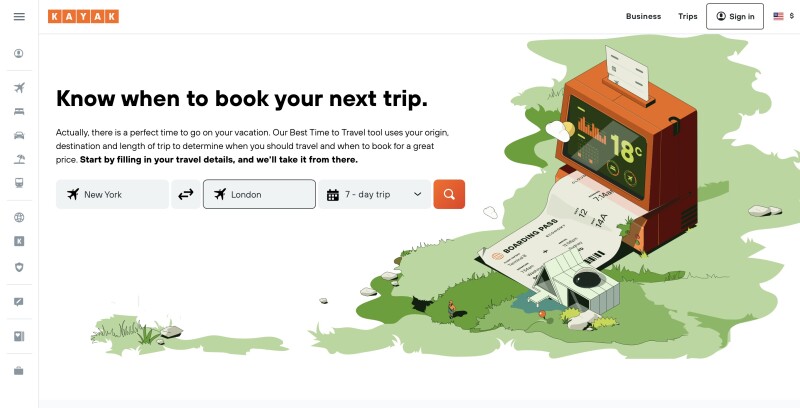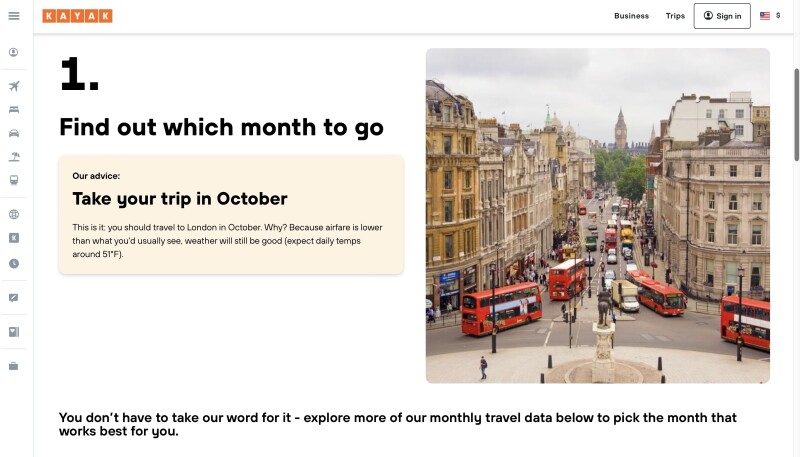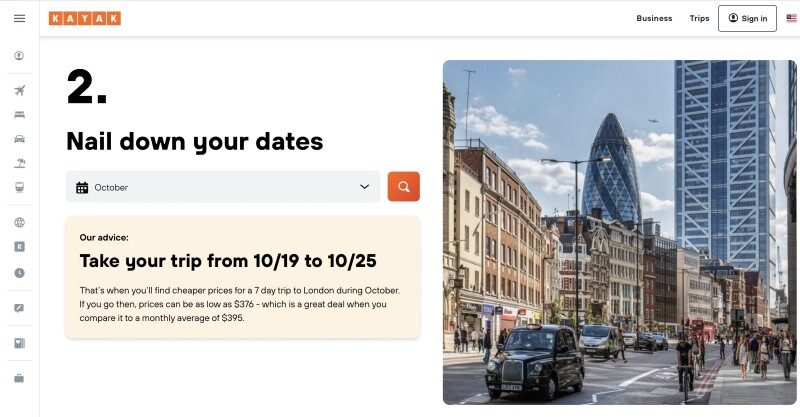In the face of recent price hikes, Kayak, a top travel search engine, recently unveiled a new way to help travelers find more affordable airfare. Dubbed the Best Time to Travel tool, this new feature helps travelers discover the most cost-effective times of year to fly to the destination of their choice (beyond the obvious low season). It also suggests whether to book now or later, based on predictive data. Overall, the tool involves a three-step process that’s quick, easy, and insightful and is best for those who know where they want to go, but are still deciding when.
Whether or not you subscribe to Kayak or use its booking engine, the website—and the planning instruments embedded therein—are something everyone can use for free (including this one). Here’s how to use this new tool to save money on your next trip.
What you need to know before you start
The landing page for the Best Time to Travel tool is clean and easy to digest, but you’ll need to have a few bits of information ready: Where you’re flying from, where you’re flying to, and if you are looking for a 4-, 7-, or 14-day trip. Once you complete these initial fields, the three-step process begins. For explanation purposes, I’ll use an example of New York City to London for seven days.

To start, you’ll need to enter where you’re flying from, where you’re flying to, and if you are looking for a 4-, 7-, or 14-day trip.
Courtesy of Kayak
Step 1: Find out which month to go
Based on your desired destination and length of travel, the tool first tells you which month to take your trip. This result considers dynamic pricing, seasonality, and crowds.
Below your result, you’ll find statistics on average prices for airfare (and hotels) plus weather. Scroll down to find a chart mapping out estimated flight prices throughout the year (up to nine months into the future).
For my NYC to London trip, at this moment Kayak recommends an October trip, citing lower airfare and statistically pleasant weather.

Kayak bases its recommendation on flight prices, weather, and how crowded a destination can be.
Courtesy of Kayak
Other stats posted on the page reveal that September-October is typically the cheapest time to travel, what to expect in terms of the average daily hotel rate in London, and advice to avoid August when the city swells with tourists. A chart shows predicted flight prices from now until January 2024.

Compare the cost of flights month by month.
Courtesy of Kayak
Step 2: Nail down your dates
If you are happy to trust Kayak’s advice on your travel timeframe, the next step is to pick exact dates. Once you hit the search bar with the prefilled month (from Step 1’s results), you’ll find out the exact dates when flights are cheapest. Below this new result, you can scroll the price bar over dates across the entire month to see the cheapest flights on alternate dates. Note that you can change the prefilled month to other months in case you aren’t completely content with the month Kayak has suggested. Also note that low-cost carriers will be included in your results.
For our example, Kayak advises I take my NYC to London trip from October 19 to 25, based on the costs over those dates being cheapest.

Kayak even helps find the best dates to fly within its recommended month.
Courtesy of Kayak
I can then play with the dates by sliding the price predictor back and forth.

This tool also allows you to compare airfare day by day.
Courtesy of Kayak
Step 3: See when to book
In this step, Kayak reveals whether it’s smarter to book now or later. This information is based on predictive data from Kayak’s billions of travel queries, which are used to forecast future flight and hotel prices. For my NYC to London trip, Kayak recommends I book my flight now and hotels at my leisure. (I ran other test trips that yielded suggestions to wait to buy airfare.)

Finally, Kayak recommends if you’d need to book those flights now or later.
Courtesy of Kayak
To book now, I hit “Find your Flight” and reach price results. Since I’m not ready to book just yet, I then sign up for a Price Alert for notifications on when prices will rise and fall for my flight dates.
Analysis
Kayak’s new Best Time to Travel is a good resource for beginners and is a great kick starter to planning a trip. For those who already know where they want to go but not when, the information is presented clearly and can help determine an idyllic timeframe for getting good value and decent weather. Since the tool incorporates data from low-cost carriers, you’ll need to be flexible with your flight choices to get the most affordable fares.
In my case, I sifted through the information for my NYC to London trip after hitting “Find your Flight” and realized that though I’d love to fly to London on the cheap, I’m not willing to do so with a layover in Iceland and landing at Stansted airport. I then dove deep into the information presented, pricing a nonstop flight versus one with a stop, choosing an airline, timing, and more before setting up my specific Price Alert. I realized that someone like me who prefers a legacy carrier and wants to earn miles for flights (and get free bags with status) is better off using a different instrument than Best Time to Travel.
An alternative I like is Kayak’s other tool, Kayak Direct, which launched back in 2011 as a hackathon project among the Kayak product team. Kayak Direct is a great resource for deciding where to go. The tool reveals destinations that can be reached via nonstop flights from a desired airport (big and small) and populates a scrollable world map that shows the current lowest price to reach various destinations. Kayak Direct is excellent when flexibility is an option.
But my favorite for deciding where and when to travel remains Google Flights. You can type in your origin and destination and find the cheapest one-way, round-trip, and multi-city fares typically 330 days into the future. An interactive calendar allows you to explore date ranges and lowest fares by airport code, city, or nearby airport. Plus, you can assess broader trip options and price them out with Google Flights’ interactive map. Unlike Kayak’s Best Time to Travel tool, Google Flights populates actual current fares and does not predict future fares or offer advice regarding when to purchase.
Takeaway
By understanding and using the power of the Best Time to Travel tool, you can figure out how to fly to your destination in a cost-effective manner and try to work around recent spikes in airfare. This doesn’t substitute for our favorite travel duo, Wikipedia + Google Flights, or Kayak Direct, but it’s an easy-to-use instrument for beginners.








